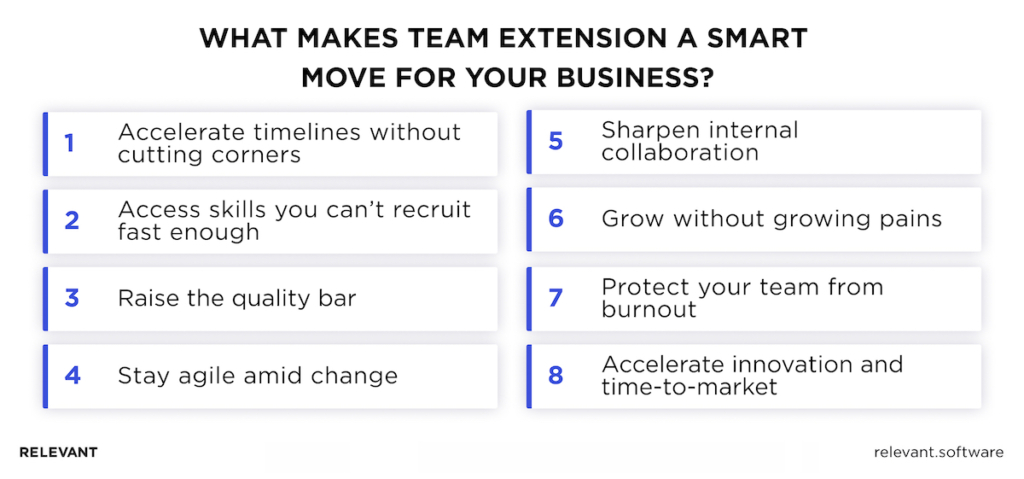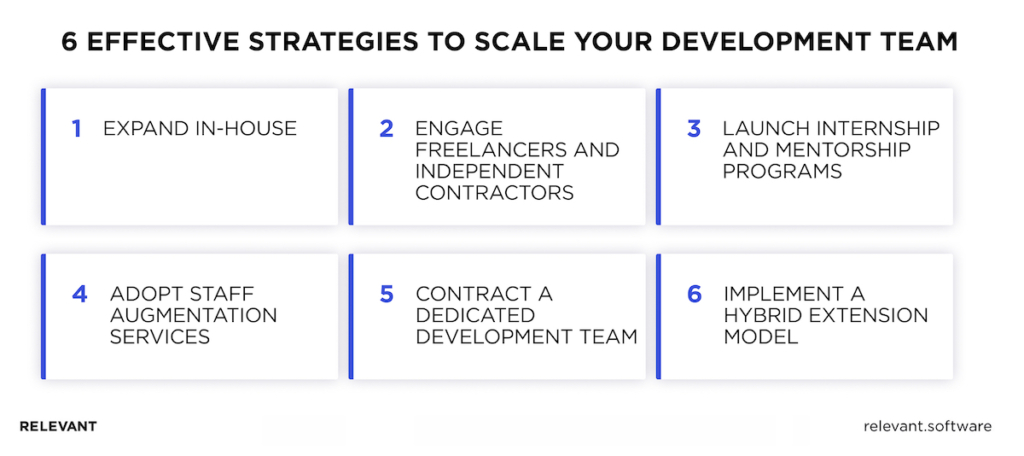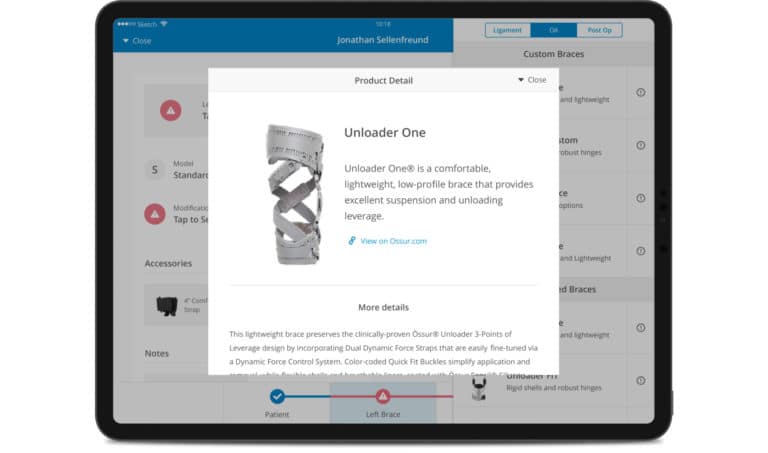Top Ways to Expand Your Software Development Team
Updated: July 10, 2025
Hiring alone isn’t fast enough for today’s software development. With shorter release cycles and growing competition, leading tech companies are moving from traditional hiring to more flexible development team extension models. The reason is simple: teams need to scale up or down instantly, and waiting for HR to catch up just slows everything down.
Team extension addresses more than speed. It introduces structural flexibility. With a global shortage of over 4 million software engineers projected by 2025, the companies advancing fastest are those that expand through vetted, on-demand talent. Instead of waiting over 40 days to secure a single hire, they integrate fully aligned engineers in under two weeks – experts already familiar with the required stack, workflows, and delivery standards.

We provide companies with senior tech talent and product development expertise to build world-class software. Let's talk about how we can help you.
Contact usAt Relevant Software, we help companies hire dedicated development teams that work as a natural extension of their business. In this guide, we explain six proven ways to expand your software team, show where each model adds the most value, and share real examples of how our clients launch products faster and reduce development costs through long-term, reliable partnerships.
Table of Contents
Why consider team extension for your business
Once upon a time, software teams fit in one room, product roadmaps stretched for years, and hiring a new engineer didn’t feel like winning the lottery. Today, it’s a different story. Deadlines move faster than budget approvals, frameworks change mid-sprint, and the “perfect candidate” is usually fielding five other offers.
That’s why modern tech leaders don’t rely solely on full-time hires. They extend their teams, adding expert engineers who already know the tools, the pressure, and the pace. A software development team extension lets companies move fast without breaking things or burning out internal staff.
If it feels like your team’s either under pressure or underwater, team extension may be the smartest move you can make. Here’s what the data shows:

Accelerate timelines without cutting corners
The median time to hire a single software engineer sits at 44 days; extension partners place qualified talent in as little as two weeks, reclaiming almost a month of productive work.
Access skills you can’t recruit fast enough
IDC (International Data Corporation) puts the global shortfall at four million software engineers by 2025. Extension services give you access to global talent, so you can bring in the right experts exactly when you need them, whether it’s to handle a new framework, address changing security requirements, or solve performance issues.
Raise the quality bar
Google’s 2024 DORA study links broader code-review participation to a 3.4% rise in overall code quality and a similar gain in review speed. External reviewers add fresh eyes, uncover hidden defects, and lift test coverage.
Stay agile amid change
Grand View Research anticipates that the IT staff augmentation market will reach $147 billion by 2028. This shows that companies are increasingly using flexible teams to adjust to changing plans without slowing down.
Sharpen internal collaboration
Extension engineers handle specialized tasks, allowing your core developers to focus on system architecture, planning, and stakeholder communication. Clear role boundaries lead to shorter meetings and more thorough code reviews.
Grow without growing pains
Deloitte notes that healthcare organizations can cut operating costs by up to 28% by outsourcing non-core work, letting them invest more in product innovation instead of extra payroll. Other industries see similar savings when they mix full-time teams with flexible, on-demand staff.
Protect your team from burnout
JetBrains’ 2023 Developer Ecosystem report finds that 73% of developers have experienced burnout during their careers. Extra capacity during peak sprints spreads workloads, safeguards morale, and supports long-term retention.
Accelerate innovation and time-to-market
A Deloitte study reports that companies adopting flexible IT service models (such as staff augmentation and other extension arrangements) achieve a 30 % faster time-to-market during growth phases and cut total cost of ownership by 25 %
These data points confirm that a well-designed extension strategy improves velocity, widens the talent base, and protects team health, all while maintaining a firm grip on cost and risk.
6 proven ways to extend your software development team
Software projects often face shifting scopes, hard deadlines, and talent gaps that internal teams cannot always cover. Instead of overloading core team engineers or slowing delivery, many companies choose to extend their development capacity by hiring additional developers through flexible team models.

1. Expand in-house
Hiring full-time engineers adds capacity inside your walls. This approach builds an extended software development team that shares your culture, time zone, and daily routines. It fits firms that handle sensitive data, require strong face-to-face collaboration, and plan to own every line of code for years.
| Key Aspect | Upside for the business | Downside to сonsider |
| Project control | Assigning tasks directly and tracking progress in real time helps keep the work on target, especially when using project management tools. | Managers must spend more time on supervision as the staff grows. |
| Communication rhythm | Shared office hours remove language or time-zone gaps, so blockers clear fast. | A close-knit team can sometimes fall into groupthink and ignore fresh ideas from outside the group. |
| Cultural alignment | Engineers absorb company values, which support unified planning and higher engagement. | Overemphasis on internal culture may slow the adoption of new practices. |
| Data security | Work stays on corporate hardware behind internal firewalls, reducing third-party exposure. | Strict on-premise rules can limit flexibility for remote specialists. |
| Recruitment cycle | No vendor fees when talent arrives through direct channels. | Hiring someone in-house takes about 44 days on average, and that’s not counting recruiter fees, job ads, and time spent on interviews. It slows down team expansion and makes it more expensive. |
Need a side-by-side view of in-house vs outsourcing? Our full guide on extended development team strategies breaks down cost, speed, and risk so that you can compare models with confidence.
Expanding an in-house team supports long-term stability and deep alignment with internal culture and workflows. This model offers full control but requires time, budget, and managerial resources that not every project can afford. When hiring delays or overhead begin to slow progress, many organizations shift to more agile options, starting with independent contractors who offer faster onboarding and targeted skills without permanent commitments.
2. Engage freelancers and independent contractors
Freelancers give you a fast software team extension for skills you do not have in-house. They join projects quickly and leave when the job is done. This path works well for short, specialised tasks like UX polish, API tuning, or proof-of-concept demos.
| Aspect | Benefits of freelancers & contractors | Drawbacks to monitor |
| Agility | Fast onboarding brings in specialized experts quickly during tight deadlines, making it a great fit for flexible team expansion for software development. | Short-term contracts make it harder to keep team knowledge and long-term understanding of the project. |
| Cost efficiency | Pay only for delivered work; no benefits, office space, or long-term payroll. | Highly skilled experts often charge more per hour, and if you need them on short notice, it can cost even more. |
| Range of skills | Access cloud, DevOps, AI, or UI experts worldwide; easy to hire developers with rare frameworks. | Freelancer skills can vary a lot. Without careful screening, you might spend months realizing they’re not the right fit, wasting time and money, with no promise of finding a better one quickly. |
| Scalability | Team size expands or contracts in days, not weeks, supporting dynamic roadmaps and outsourcing IT team extension goals. | Over-reliance creates delivery risk if a key freelancer leaves mid-cycle. |
You can find a freelancer vs software company comparison here.
Freelancers and independent contractors provide fast access to specialized skills, making them a useful choice for short-term or highly specific development needs. They support rapid delivery without long-term overhead, but quality control and continuity can suffer without strong oversight. When project complexity grows or consistency becomes a priority, many companies transition to structured team-extension models like internships and mentorship programs.
3. Launch internship and mentorship programs
Internships and mentorship programs add fresh talent to a development team extension without a large upfront cost. Interns bring new ideas from university labs, while mentors refine leadership skills within the extended development team. This low-risk team-extension model keeps payroll lean and builds a pipeline of future full-time engineers, an advantage when you need flexible team expansion for software development.
| Aspect | Advantages of mentorship | Watch-outs to manage |
| Future talent | Strong interns often return as junior engineers, so you spend less time on later searches | High turnover means each season restarts onboarding and knowledge transfer. |
| Fresh perspectives | Students share up-to-date tools and research, sparking innovation across extended teams. | Code from beginners needs close review to meet production quality. |
| Cost control | Hourly spend stays well below junior salary levels, supporting flexible team expansion for software development. | Senior engineers must invest hours in coaching and feedback. |
| Learning culture | Mentors practise leadership and knowledge transfer, raising overall team maturity. | Success depends on clear goals, structured feedback, and available mentors. |
| Scheduling fit | Extra hands arrive during busy summer sprints or proof-of-concept phases. | University calendars may not match urgent launch timelines. |
With clear tasks, active mentorship, and regular feedback, internship tracks turn into a steady talent stream that strengthens any software team extension strategy. But when delivery timelines tighten or senior bandwidth thins, tech leaders often look beyond internal development to IT staff augmentation services with engineers who can onboard in days.
4. Adopt staff augmentation services
A trusted vendor supplies vetted engineers who join your stand-ups in one to two weeks. These staff augmentation services provide an efficient IT team extension for companies facing tight deadlines yet wishing to keep internal processes intact. Many clients draw talent from team extension hubs in Europe, such as Poland and Ukraine.
| Aspect | Benefits of partnering with an IT staff augmentation company | Risk to monitor |
| Global Talent Access | Staff augmentation services connect you with skilled engineers worldwide, filling hard-to-find roles | Long missions can cost more than hiring full-time staff, so compare total spend to value received. |
| Scaling Speed | You can adjust team size in just a few days, so your extended development team stays aligned with your current workload. | New arrivals still need clear tasks, tools, and contacts; without this, collaboration slows. |
| Hiring Cost | No internal recruiting, interview, or payroll overhead. The agency fee covers it. | Hourly rates can rise on long projects; compare the cost against the speed gained. |
| Team integration | Reputable vendors align new engineers with your culture, tools, and Agile rituals, creating a smooth team-extension model. | Cultural differences, unclear documentation, or mismatched expectations can hinder collaboration with your new team members across borders. |
| Core Focus | Internal staff stay on product vision and architecture, while augmented engineers cover delivery tasks. | Split ownership requires clear roles; blurred lines may weaken accountability. |
| Control Balance | You set goals and review progress while the vendor manages staffing details. | Project managers must monitor work closely to keep scope, budget, and quality on track. |
Staff augmentation allows businesses to extend their team capacity quickly by integrating vetted engineers from a trusted provider. This model works best when internal processes remain stable and project ownership stays in-house. However, for projects requiring full-cycle execution, broader accountability, or strategic expansion, many companies choose to hire a dedicated development team.
5. Contract a dedicated development team
A dedicated development team is a full, self-managed group of developers, QA, PMs, etc. that works exclusively on your project, from planning to deployment. This full outsourcing IT team extension is ideal for complex projects that require stable, end-to-end delivery and specialist expertise across multiple domains.
| Area | Benefits of a dedicated development team | What to watch when you outsource projects to a dedicated development team |
| Special-Skill Access | You gain people who already know AI, fintech, or high-traffic apps — skills your staff may not have. | Set clear knowledge-transfer milestones; without them, critical IP may remain with the vendor. |
| Efficiency & focus | A single-purpose team works only on your backlog, raising delivery speed and quality. | Set sprint schedules and key goals early on. If they’re not aligned, it can slow progress and weaken results. |
| Core-team relief | Your own engineers stay on strategy and big decisions, while the extended development team handles everyday coding and testing. | Maintain one in-house product owner to avoid blurred scope and decision delays. |
| Cost optimisation | You skip local hiring, office space, and benefits, lowering the total cost of ownership, one reason many firms choose this outsourcing model. | Hourly rates might seem cheap at first, but if extra work or overtime isn’t tracked, costs can quickly add up. |
| Scalability & flexibility | Team size can grow or shrink quickly, especially with Eastern European teams, so you always have the right capacity for your project needs. | Quickly reducing team size can lead to lost knowledge about the project. To avoid this, make sure you’re always documenting key steps and decisions. |
| Security & compliance | Reputable vendors enforce secure DevOps pipelines and meet GDPR, SOC 2, or PCI rules, safeguarding code across the outsourcing model. | Run regular security audits and keep core credentials in your cloud account to maintain control. |
Outsourcing projects to a dedicated development team is a smart way to extend your software team: you tap into specialist skills, complete work faster, and keep in-house staff focused on core priorities. Most risks, such as gaps in quality, communication, or accountability, disappear when you partner with a credible tech provider that supplies vetted engineers, clear SLAs, and ongoing oversight. If you still need maximum flexibility and full internal ownership of key components, a well-run hybrid model can deliver the best of both worlds.
6. Implement a hybrid extension model
A hybrid extended team model keeps a core group of in-house engineers while adding outside talent, either through outsourcing, staff augmentation services, or freelancers, whenever extra capacity or niche skill sets are needed. This flexible team-extension model combines the best of both worlds: in-depth product knowledge inside the company and on-demand expertise from external partners.
| Area | Why a hybrid model helps extend dedicated software development team | Points to watch when you blend in-house and external teams |
| Scalability | Add or remove people quickly, so your development team extension always fits the current project demands. | Fast changes require clear onboarding plans; without them, ramp-up time rises. |
| Cost control | Use in-house staff for core work and outsource peak tasks, keeping payroll lean and meeting tight budgets. | Track vendor hours and scope; unchecked overtime erodes savings. |
| Skill diversity | Mix internal domain knowledge with outside specialists, giving the product a wider range of ideas and tools. | Align coding standards early; different habits can slow reviews. |
| Innovation boost | Fresh viewpoints from extended teams often spark new features and process improvements. | Too many viewpoints can stall decisions; assign one product owner to keep focus. |
| Risk balance | Workload is spread across multiple groups, so illness, turnover, or local outages affect the roadmap less. | Over-reliance on a single vendor creates a bottleneck if that partner fails to deliver. |
A hybrid approach delivers both control and agility. Success hinges on clear ownership, consistent quality standards, and solid knowledge-sharing between your in-house staff and the external team extension services you engage.
How сlients grew faster with our extended teams
At Relevant Software, we tailor development team extension models to fit each client’s strategy, whether through a full dedicated development team, flexible staff augmentation, or a hybrid delivery model. By aligning with specific business needs, accessing a global talent pool, and guiding clients through the entire development process, we ensure each solution becomes a good fit for the company’s goals.
Volkswagen Genser App: marketing & advertising, Norway
A technology company in Oslo needed a cross-platform mobile product that blended beacon tracking with gamified rewards. Relevant Software built an extended development team skilled in React Native, Firebase, and iBeacon integration. The team delivered a single codebase for iOS and Android, completing the entire development process on time and within budget.
Results show improved foot traffic and stronger campaign engagement. Client feedback praised not only the speed and quality but also the cultural fit and clarity across all project stages — a key consideration when working with outsourcing partners.
RED Driver Training: EdTech, United Kingdom
RED Driver Training, the UK’s largest driving school network, aimed to enhance its learning platform. Relevant Software provided a dedicated development team that transformed an acquired app into a full-featured solution, custom-built for RED’s roadmap.
The rebuilt product included timed quizzes, in-app feedback, a content management system, and algorithm-driven learning paths. This complex project demonstrated how a well-integrated team extension can adapt to evolving business needs while avoiding hiring delays. More than 65% of RED’s learners now rely on the new app, and early feedback confirms a strong product-market fit.
Intended Future: automotive, Sweden
When Intended Future needed to validate a new Power BI-driven portal, they turned to Relevant Software’s extended team model. We supplied a focused team, which included two developers, a QA, and a business analyst, to deliver a working prototype under tight deadlines and budget constraints.
The team completed the entire development process in just four weeks, including analytics dashboards and user access controls. The client benefited from a global talent pool while staying in control of core decisions. By working closely with both product stakeholders and state authorities, the solution addressed both internal business goals and external regulatory needs.
Extend your software development capacity with Relevant Software
Digital goals feel within reach when the right people stand beside you. Relevant Software offers a flexible set of team-extension services, from a dedicated development team that owns your backlog to focused staff augmentation for specialised skills.
Our external developers integrate into ongoing projects within days, bringing a proven track record, a broad range of services, and fresh, different perspectives. They respect your tools, security policies, personnel records, and company culture from day one, aligning with current IT staff augmentation trends to strengthen delivery without disruption.
Whether you are:
- A startup that needs end-to-end product delivery,
- A growing company aiming to expand features without slowing releases, or
- An enterprise seeking niche expertise for AI, cloud, or data modernisation…
….Relevant Software plugs the exact skills and capacity you need – when you need them, helping you build an extended development team that fits your roadmap and release goals. Let’s build your extended development team together. Contact us to get started.
Our core services:
Do you want a price estimate for your project?
Do you know that we helped 200+ companies build web/mobile apps and scale dev teams?
Let's talk about your engineering needs.
Write to us











